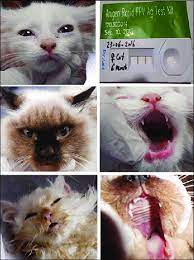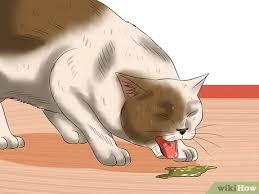Feline Panleukopenia Virus (FPV), also known as feline distemper, is a highly contagious and potentially deadly viral disease that affects cats. It belongs to the parvovirus family and shares similarities with the canine parvovirus. This disease can be a significant threat to feline populations, especially among unvaccinated cats or kittens. In this blog, we will delve into the etiology, pathogenesis, clinical signs, treatment options, and preventive measures associated with FPV to help you better understand and protect your feline companions.
Etiology of Feline Panleukopenia Virus:
Feline Panleukopenia Virus is caused by a small, hardy virus known as parvovirus. The virus is highly resistant and can survive in the environment for extended periods, making it particularly dangerous in areas with high cat populations. FPV primarily spreads through contact with infected bodily fluids or contaminated environments, such as litter boxes, food and water dishes, and grooming equipment.
Pathogenesis of FPV:
The pathogenesis of FPV begins with the virus entering the cat’s body through the mouth or nasal passages. It then replicates rapidly in the lymphoid tissues of the throat, tonsils, and mesenteric lymph nodes, leading to a significant drop in the white blood cell count (panleukopenia). This virus also attacks rapidly dividing cells in the intestinal lining and bone marrow, causing severe gastrointestinal symptoms and immunosuppression.
Clinical Signs of Feline Panleukopenia :
Feline Panleukopenia can manifest with a range of clinical signs, which may vary in severity. Common symptoms include:
1. Fever
2. Lethargy
3. Vomiting
4. Diarrhea (often bloody)
5. Dehydration
6. Anorexia
7. Weight loss
8. Abdominal pain
9. Weakness

In severe cases, FPV can lead to neurological signs such as ataxia, seizures, and even sudden death, especially in kittens. It’s essential to seek immediate veterinary care if you suspect your cat has been exposed to the virus and displays any of these symptoms.
- You can visit our YouTube channel for more details.
Feline Panleukopenia Treatment:
There is no specific antiviral treatment for FPV, so supportive care is crucial in managing the disease. Treatment may include:
1. Hospitalization: Cats with severe symptoms may require hospitalization to receive intravenous fluids to combat dehydration and electrolyte imbalances.
2. Nutritional support: Some cats lose their appetite, and force-feeding or nutritional supplements may be necessary to maintain their strength.
3. Medications: Antibiotics may be prescribed to prevent secondary bacterial infections. Anti-nausea medications can help control vomiting.
4. Isolation: Infected cats should be isolated to prevent the spread of the virus to other felines.
Preventive Measures:
Prevention is the most effective way to protect your cat from FPV. Here are key preventive measures:
1. Vaccination: Ensure that your cat receives the appropriate vaccinations as recommended by your veterinarian. The FPV vaccine is highly effective in preventing the disease.
2. Quarantine: If you bring a new cat or kitten into your home, quarantine them for at least two weeks to ensure they are not carrying the virus.
3. Hygiene: Regularly clean and disinfect litter boxes, food and water dishes, and any shared cat equipment.
4. Isolation of sick cats: If you have a cat with FPV, keep them isolated from other cats to prevent the spread of the virus.
Conclusion:
Feline Panleukopenia Virus is a serious threat to cats, especially those that are not vaccinated. Understanding the etiology, pathogenesis, clinical signs, treatment options, and preventive measures is essential for cat owners. By taking the necessary precautions, including proper vaccination and hygiene, you can significantly reduce the risk of your feline friend contracting this potentially deadly disease. If you suspect your cat may be infected, don’t hesitate to contact your veterinarian for prompt diagnosis and treatment. Your vigilant care can make all the difference in ensuring your cat’s health and well-being.
FAQs
Q: Can humans get infected with Feline Panleukopenia Virus? A: No, this virus is specific to cats and does not affect humans.
Q: Is Feline Panleukopenia Virus preventable? A: Yes, with proper vaccination and hygiene practices, the virus can be prevented effectively.
Q: How is the virus transmitted?
A: The virus is primarily transmitted through direct contact with an infected cat’s bodily fluids or contaminated environment.
Q: Can an infected cat recover?
A: With early and intensive treatment, some cats can recover, but the survival rate is not high.
Q: What is the vaccination schedule for Feline Panleukopenia Virus?
A: Kittens should receive their first vaccine at 8-10 weeks of age, with boosters following every 3-4 weeks until 16 weeks of age.
Q: How long can the virus survive in the environment?
A: The virus can survive for months in the environment, so thorough cleaning and disinfection are essential


Content is appropriate and very informative thank you sir
Very informative and well explained sir G❤👍
Informative 👍👍
Appropriate Content
It is very clearly Explained and very easy to understand and very informative for Veterinary Doctor’s.
Full of knowledge
Wonderful knowledge 👌
Wonderful knowledge
Very informative
Nice information
Well explained
Nice sir g.
You have given a very clear and detailed explanation, sir.
A great threat to feline family..
Very informative 😍
Very informative
Very informative notes sir g 🌹❤️
Ma sha Allah Dr sb ❤️🤍
Well deserve
Informative
Informative
Content is appropriate and very informative thank you sir
Content is useful and very informative thank you sir……
Content full of knowledge
Very informative sir 😍
Briefly explained
Very well explained sir jee.
Well explained
Wow Informative 〽️🎶
Totally understanding Things 🤩❤️
Great work ♥️
Good work sir😍😍
Very impressive sir g
Very informative
Very informative 😍
Very clear
Very Informative
Dude, you just dropped some serious knowledge bombs! Thanks for sharing this enlightening content. You’re the coolest! 🤓🌟
Thank u sir for sharing yourr knowledge with us …Keep sharing 😍
Informative and knowledgia✨
Very detailed and informative content. Thanks for sharing your knowledge.